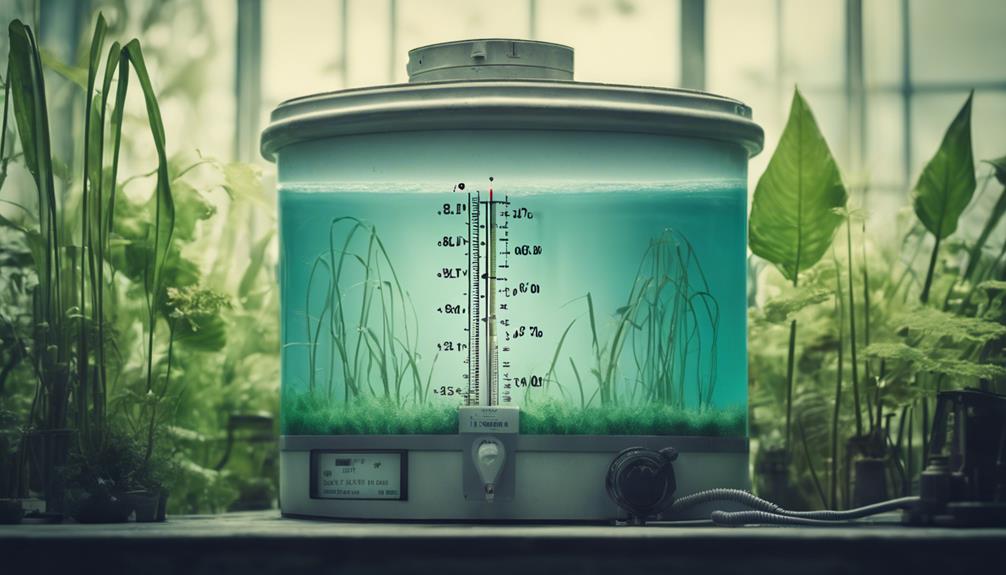You're experiencing rising pH levels, and it's vital to understand why. Respiratory alkalosis, metabolic alkalosis, and a diet high in alkaline foods can all contribute to increased pH levels. Additionally, agricultural practices, soil mineral imbalances, and human activities like using sanitizers can also raise pH levels. To fix the issue, monitoring and adjusting total alkalinity levels is key, regularly testing water and maintaining a stable pH balance. By identifying the root cause and making adjustments, you can restore balance and alleviate associated health problems. Now, learn how to pinpoint the source of the imbalance and take corrective action to restore your body's natural pH balance.
Table of Contents
Key Takeaways
- pH levels rise due to factors like respiratory alkalosis, metabolic alkalosis, diet, agricultural practices, and human activities that alter soil and water chemistry.
- A diet high in alkaline foods, soil mineral imbalances, and aeration of water can also contribute to rising pH levels.
- To fix rising pH levels, regularly test water, monitor and adjust Total Alkalinity levels, and maintain a range of 80-120 ppm for ideal pH stability.
- Factors like algae outbreaks, plant stress, and root disease can cause pH rise, and regular cleaning and maintenance can help prevent this.
- Chemical additions, biological activity, and water temperature can affect pH levels, and understanding these factors is crucial to maintaining a stable pH balance.
Understanding Ph Levels
When you think about pH levels, you must recognize that your body's delicate balance relies on maintaining a specific pH range, as even slight deviations can have a profound impact on your overall health.
Your body naturally maintains pH balance on its own, with the kidneys playing a vital role in filtering acids and bases.
pH levels are measured on a scale of 0-14, with 7 being perfectly neutral. Each whole number on the pH scale represents a 10x difference in hydrogen concentration, making it essential to understand the pH scale to grasp the significance of pH imbalances.
In the context of water, the ideal pH level is approximately 7, indicating a natural pH.
This natural pH is essential for your body's functions, including digestion, hormones, and metabolism.
When you consume water with a high pH value, it can affect your body's natural pH balance, leading to digestive issues, hormonal imbalances, and metabolic problems.
Understanding pH levels is vital to recognizing the importance of maintaining a balanced pH range in your body and the water you drink.
Causes of Ph Rise
Your body's natural pH balance can be disrupted by various factors, leading to a rise in pH levels. When your body's pH levels rise, it can lead to an alkaline state, which can cause a range of health issues. So, what causes a high pH?
| Causes of pH Rise | Description |
|---|---|
| Respiratory Alkalosis | When your body takes in too much oxygen, it can cause your pH levels to rise. This can occur due to hyperventilation, anxiety, or other respiratory issues. |
| Metabolic Alkalosis | An imbalance of electrolytes, such as potassium and sodium, can cause your pH levels to rise. This can occur due to certain medications, hormonal imbalances, or other underlying health conditions. |
| Dietary Factors | Consuming a diet high in alkaline foods, such as fruits and vegetables, can raise your pH levels. While a balanced diet is essential, an overconsumption of alkaline foods can disrupt your body's natural pH balance. |
Understanding the causes of pH rise is vital in maintaining your body's natural pH balance. By identifying the underlying causes, you can take steps to address the issue and restore balance to your body.
Natural Ph Increase Factors

As you explore the natural pH increase factors, you'll discover that soil mineral imbalances play a significant role.
When the soil's mineral composition is out of balance, it can impact the pH levels of surrounding water.
You'll also find that human activities, such as certain agricultural practices, can inadvertently contribute to rising pH levels.
Soil Mineral Imbalance
One primary natural factor contributing to rising pH levels is an imbalance of essential minerals in the soil, which can occur when calcium and magnesium ions are depleted, allowing sodium and potassium ions to dominate.
When this happens, your soil's pH levels will naturally rise, making it more alkaline. As a result, you may notice that your plants are struggling to thrive, as they prefer a more acidic environment.
You might be wondering why this imbalance occurs in the first place. Well, it's often due to soil erosion, leaching, or over-fertilization, which can deplete calcium and magnesium reserves.
If left unchecked, this imbalance can lead to a continuous pH rise, making it challenging to lower pH levels. To avoid this, you must monitor your soil's mineral composition and take corrective action when necessary.
Human Activities Impact
Human activities, including the use of sanitizers and chlorine generators, can inadvertently contribute to rising pH levels in water and soil.
When you use sanitizers, you may be affecting your pool's pH levels. For instance, chlorine gas and trichlor are acidic, which lowers pH, while dichlor and bromine have a relatively neutral impact. On the other hand, salt chlorine generators can raise pH due to off-gassing hydrogen bubbles.
You may not be aware that aeration of your water can also cause pH to increase. This is because aeration releases carbon dioxide, leading to a rise in pH. Additionally, algae consume carbon dioxide, which also raises pH.
To counteract this effect, you can increase dissolved CO2 by injecting pure CO2 or adding acid. This will help lower pH levels. You must monitor your pH levels and take corrective action to maintain a balanced environment.
Chemical Contributions to Ph
As you examine the chemical contributions to pH levels, you'll notice that the presence of acidic substances can substantially impact pH values.
These substances, such as sulfuric acid and nitric acid, can reduce pH levels by increasing the concentration of hydrogen ions.
On the other hand, an influx of alkaline chemicals can have the opposite effect, increasing pH levels by introducing hydroxide ions into the system.
Acidic Substances Presence
The presence of acidic substances in water substantially contributes to pH level increases, primarily due to their ability to release excess hydrogen ions. When you introduce acidic substances into water, they dissociate into hydrogen ions, which then react with hydroxide ions to form water, causing pH levels to rise. This phenomenon is particularly concerning, as it can lead to a low pH, which can have detrimental effects on aquatic life and human health.
| Acidic Substance | pH Level Effect | Examples |
|---|---|---|
| Carbonic acid | Raises the pH | Fizzy drinks, atmospheric CO2 |
| Sulfuric acid | Causes pH increase | Industrial processes, vehicle emissions |
| Nitric acid | Contributes to pH rise | Fertilizers, industrial processes |
As you can see, various acidic substances can cause pH levels to increase. Identifying and addressing these sources is crucial to maintain a healthy and balanced ecosystem. By understanding the role of acidic substances in pH level increases, you can take steps to mitigate their impact and create a more sustainable environment.
Alkaline Chemical Influx
Introducing alkaline chemicals into water can substantially raise pH levels by releasing excess hydroxide ions that neutralize hydrogen ions. As you add these chemicals, you're basically balancing the pH levels by counteracting the acidity.
One common alkaline substance responsible for this phenomenon is sodium bicarbonate, commonly known as baking soda. When you add sodium bicarbonate to water, it breaks down into sodium and bicarbonate ions, which raise the pH.
You might wonder why this matters. Well, when your water's pH keeps increasing due to alkaline influx, it can have significant effects on your water quality.
For instance, high pH levels can lead to scaling, corrosion, and even affect the taste and odor of your water.
To fix this issue, you'll need to identify the source of the alkaline chemicals and remove or neutralize them. By doing so, you'll be able to maintain a stable pH level, ensuring your water remains safe and healthy for consumption.
The Role of Alkalinity

You're likely aware that total alkalinity (TA) plays a crucial role in stabilizing pH levels, with a recommended range of 80-120 ppm to effectively buffer against pH fluctuations. But did you know that TA levels can directly impact pH rise?
| TA Level (ppm) | pH Rise | pH Stability |
|---|---|---|
| 50-60 | Slower | Unstable |
| 60 | Stable | Stable |
| 80-120 | Faster | Stable |
| Above 120 | Faster | Unstable |
As the table shows, low TA levels (50-60 ppm) can lead to slower pH rise, while high TA levels can result in higher pH potential with a slower rise. However, TA levels below 50 ppm can cause instability in pH levels, making it difficult to maintain a stable pH. Targeting a TA of 60 ppm can help stabilize pH, and monitoring and adjusting TA levels can help control pH rise. By understanding the role of alkalinity in pH stabilization, you can take proactive steps to maintain a stable pH and prevent unwanted pH fluctuations.
Maintaining Ph Balance
Maintaining pH balance is essential, as even slight deviations from the body's neutral state can disrupt digestion, hormones, metabolism, and overall well-being. Your body aims to maintain a homeostatic neutral state of approximately 7 pH, and even slight pH changes can cause harm.
When your pH balance is off, you may experience symptoms like sleepiness, fatigue, headache, loss of appetite, confusion, and vomiting. If left untreated, pH imbalance can lead to digestive issues, hormonal imbalances, and metabolic problems.
Fortunately, your kidneys play a vital role in filtering acids and bases to maintain pH balance. However, if you have underlying medical conditions, such as diabetes or kidney disease, your pH balance may be disrupted.
To maintain pH balance, addressing any underlying medical conditions is necessary. You may need medications, ventilators, or electrolyte solutions to restore balance. By taking these steps, you can prevent pH rise and maintain healthy pH levels, ensuring your body functions properly.
Identifying Ph Fluctuations

Fluctuations in pH levels can catch you off guard, but recognizing the warning signs and taking proactive measures can maintain a stable and healthy environment.
To identify pH fluctuations, you'll need to regularly test your water. This helps you catch sudden changes and make prompt adjustments to maintain a stable pH.
Monitoring and adjusting Total Alkalinity (TA) levels is also vital, as high TA levels can contribute to pH rise. Aim for a TA range of 80-120 ppm for ideal pH stability.
Be aware of other factors that can cause pH rise, such as algae outbreaks, plant stress, and root disease. By identifying the underlying cause, you can take targeted action to address it.
Regular cleaning and maintenance are also essential in reducing pH rise by removing debris and contaminants that can contribute to pH instability.
Stabilizing Ph Levels
By pinpointing the underlying causes of pH fluctuations, you can now implement strategies to stabilize pH levels and create a more consistent environment.
To achieve this, understand that the following factors influence pH levels. Here's a breakdown of the most critical factors:
| Factor | Impact on pH Levels |
|---|---|
| CO2 levels | Decrease pH levels |
| Alkalinity | Increase pH levels |
| Water temperature | Affects pH levels, with higher temps reducing pH |
| Biological activity | Can raise or lower pH levels |
| Chemical additions | Can raise or lower pH levels |
Frequently Asked Questions
How Do You Fix High Ph in Your Body?
You can fix high pH in your body by making dietary changes, incorporating natural remedies like apple cider vinegar, and adopting lifestyle adjustments like stress management, while also considering herbal supplements like triphala to support overall balance.
What Makes Ph Levels Go Up?
You're likely wondering what makes your pH levels go up, and it's often due to dietary factors like high sugar intake, environmental toxins in your air and water, hormonal imbalances, and stress triggers that disrupt your body's natural balance.
How Can Ph Be Corrected?
To correct your pH, you'll want to focus on pH balancing through alkalinity supplements, ensuring proper mineral replenishment, and maintaining electrolyte regulation. This multifaceted approach will help your body restore its natural balance and peak functioning.
What Do You Do When the Ph Is High?
When you're faced with high pH levels, you'll need to employ symptom management strategies, such as reducing aeration and adjusting circulation, while considering emergency protocols like partial water changes, and making lifestyle adjustments to prevent future pH imbalances.
Conclusion
As you wrap up your journey to understand pH levels, remember that maintaining balance is key.
Don't let your pH levels go haywire – keep them on an even keel by monitoring fluctuations and addressing causes promptly.
By doing so, you'll be in the driver's seat, steering your system towards a healthy equilibrium.
After all, when life gives you lemons, make lemonade – but in this case, when life gives you pH imbalances, make adjustments to get back on track!

